When I was new to gardening (and new to canning what came out of my garden), homemade tomato sauce was one of those projects that always felt a little intimidating.
Every recipe I came across called for boiling a pot of water, blanching the tomatoes, plunging them into an ice bath, then making X-shaped slits in the bottom to release the skins. Some recipes went a step further, telling me to run the peeled tomatoes through a food mill to remove the seeds.
Frankly, it doesn’t sound all that bad… until the first time you’re faced with a sink full of tomatoes (especially smaller tomatoes) that need to be peeled, one by one.
All that work, all that mess… I actually started to dread the peak-of-summer harvests when I had more tomatoes than I could use right away!

But then one summer, I thought… Why go through all the trouble of peeling and seeding tomatoes?
I actually like the flavor and texture of the skins and seeds, and when I cooked them down, the skins seemed to disappear into the sauce anyway.
Fun fact: Tomato skins contain essential amino acids and actually have higher levels of lycopene (a powerful antioxidant) compared to the pulp and seeds.
That tiny revelation became my go-to method for making a quick tomato sauce from scratch that requires not much more than a food processor (or a blender or immersion blender).
And if you decide to do a double/triple/quadruple batch, you can rest easy knowing you won’t be adding hours (or even days!) to your tomato processing.
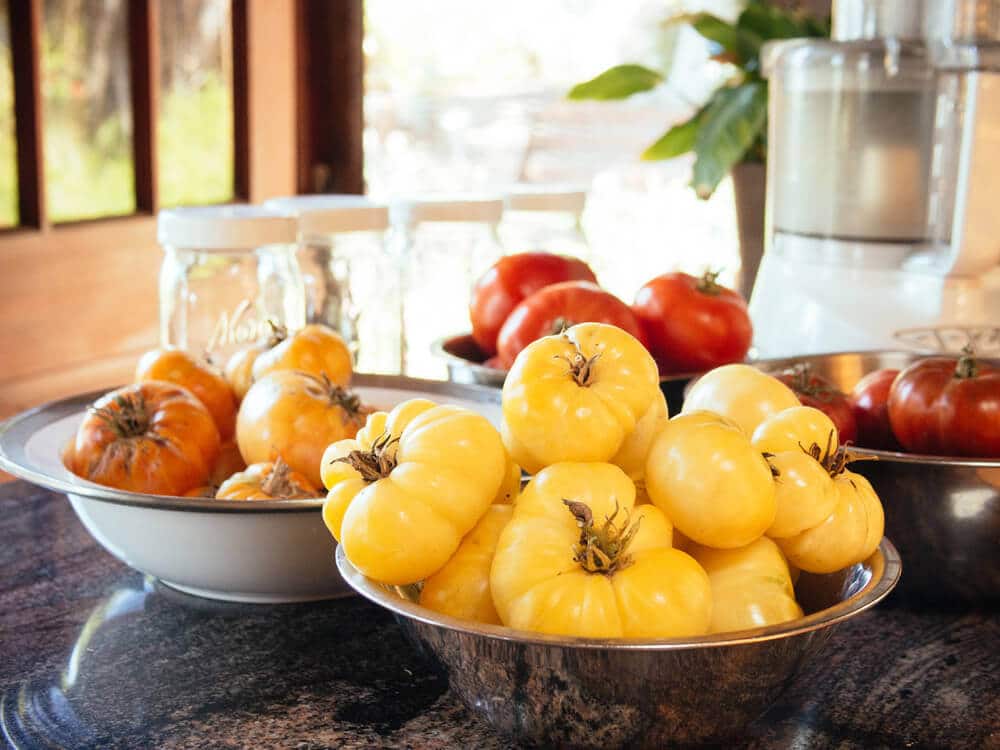
The secret to a fresh and flavorful tomato sauce from scratch
This is a basic sauce that omits the labor-intensive blanching, peeling, seeding, and straining of more traditional sauces.
It’s all tomato—and nothing else.
(Unless you’re planning to can the sauce for storage, in which case you’ll need to add bottled lemon juice for safe canning.)
I prefer to keep the sauce simple as it gives me more options when cooking. Some nights I might be feeling classic Italian marinara with basil, oregano, and garlic, other nights I might want a little arrabbiata action, and there are nights I might go for this spicy minty tomato sauce.
Whatever the mood may be, I like having a neutral sauce that I can add my garlic, onions, peppers, herbs, and spices to, without being tied down to a specific flavor profile.
By starting with a basic tomato sauce, you also reduce the chances of ending up with a bitter-tasting sauce, which sometimes happens with overcooked spices.
Quick tip: To save a bitter tomato sauce, stir 1/4 teaspoon baking soda into 1 cup sauce while it’s simmering. Taste, and keep adding tiny amounts of baking soda to see if it helps neutralize the acidity. You can also take the edge off a bitter tomato sauce by stirring in 1 tablespoon butter until it melts.
Pasta sauce isn’t the only thing you can make with your pureed tomatoes, however. The unadulterated tomato sauce is a good base for homemade ketchup, tomato chutney, tomato jam, and salsa as well, or you can simply stir it into minestrone soup, Spanish rice, or any recipe that calls for crushed or diced tomatoes.
I tend to cook the tomato sauce for less time than most recipes recommend, since I know I’ll be cooking it even more when I make the actual sauce. A shorter cooking time (I usually never go more than half an hour) means you retain more of that fresh tomato flavor.
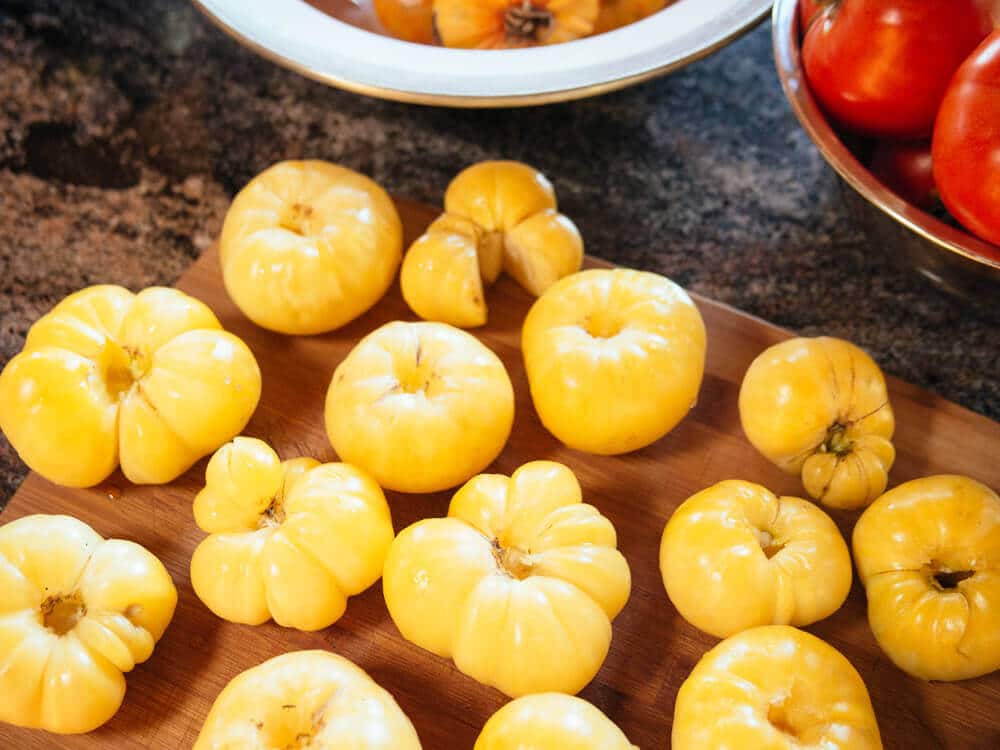
Disclosure: If you shop from my article or make a purchase through one of my links, I may receive commissions on some of the products I recommend.
How long should you cook the tomato sauce?
In general, aim for 30 to 90 minutes of simmering on the stove. Any longer than that, and you’re on your way to tomato paste.
At 30 minutes, the sauce will be thinner (reduced by about one-third) but have a lighter, fresher flavor.
At 90 minutes, the sauce will be thicker (reduced by half in volume) but have a deeper cooked flavor.
I use a deep, wide-diameter pot (this Dutch oven is great for the task, but I also use this saute pan for smaller batches) to allow the liquid to evaporate quicker. If you use a pot that’s taller than it is wide, you may need a longer cooking time.
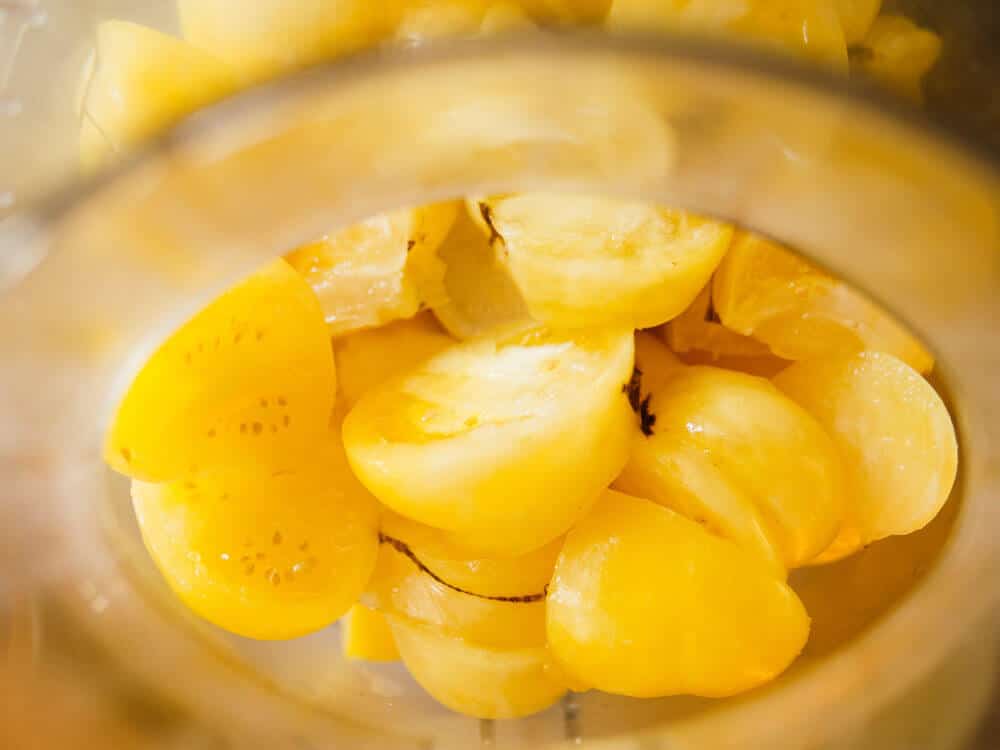
What are the best types of tomatoes to use for skins-on tomato sauce?
Any blemish-free, vine-ripened, firm-fleshed tomato can be used for sauce. Traditional recipes often call for paste or plum tomatoes, like the Roma variety, since they have thicker skin, firmer flesh, and less moisture (which means they peel easier, boil down faster on the stovetop, and make a denser sauce in less time).
But because this sauce requires no peeling, I’m a fan of using any and all tomatoes, including cherry and grape varieties.
Use the excess harvest from your garden, or seek out tomatoes at farmers’ markets, which sometimes sell their slightly bruised or blemished fruit in bulk for a great bargain. (Just be sure to slice off any blemishes before using them.)
If you love tomatoes as much as I do, you can even make a rainbow of sauces from all the colorful and delicious heirloom tomato varieties available.
I’ve turned out green tomato sauce (from ripe green tomatoes), orange, yellow, white, even a stunning maroon from a batch of beautiful purple-black fruits. It’s fun, it’s different, and it can dress up an otherwise ordinary dish.
How to safely store your tomato sauce
The sauce will keep in the fridge for up to 1 week, or in the freezer for up to 3 months (for optimal flavor).
Related: How to Safely Freeze Liquids in Mason Jars
For long-term storage, you’ll need to add bottled lemon juice in order to raise the acidity for safe canning.
The proper amount is 2 tablespoons bottled lemon juice for each quart jar.
Don’t substitute fresh-squeezed lemon juice for bottled lemon juice, as acidity levels vary widely among fresh lemons you buy or grow.
You can, however, substitute citric acid (at a rate of 1/2 teaspoon per quart jar) for the bottled lemon juice, if you already have that on hand.
Properly canned tomato sauce will keep for at least 1 year in a cool, dry, and dark environment.
Easy Peasy Homemade Tomato Sauce (No Peeling Required)
Makes 4 to 6 quarts (depending on length of simmer time)
Ingredients
15 pounds tomatoes, stems removed
8 tablespoons bottled lemon juice (optional, if canning)
Instructions
Refrigeration Method
Step 1: Working in batches, quarter or coarsely chop the tomatoes and add them to the bowl of a food processor. Pulse a few times to your desired level of chunkiness.
Step 2: Transfer the tomato puree to a large stockpot, then repeat Step 1 until all tomatoes are processed.
Step 3: Place the stockpot over medium-high heat and bring the puree to a boil. Reduce the heat and simmer uncovered, stirring occasionally, for 30 to 90 minutes until the tomato sauce is thickened to your liking.
Step 4: When the sauce is finished, let cool to room temperature, then transfer to jars and refrigerate for up to 1 week.
Alternatively, you can transfer the cooled sauce to freeze-proof containers or zip-top bags and freeze for up to 3 months.
(Tip: When storing the sauce in bags, portion them into 2-cup or 4-cup servings for ease of cooking, squeeze out the excess air and then flatten the bags before stacking and freezing.)
You can also freeze the tomato sauce in mason jars (but make sure you follow the tips in that post).
Canning Method
Prepare a boiling water bath and 4 to 6 quart-sized canning jars.
Follow the directions above through Step 3. Remove the stockpot from heat.
Transfer the hot tomato sauce to warmed jars, leaving about 1 inch of headspace.
Stir in 2 tablespoons of bottled lemon juice per jar.
Wipe the rims with a towel, then seal with lids and bands.
Process the jars in a boiling water bath for 40 minutes, adjusting time for altitude as needed.
Properly canned tomato sauce will be shelf stable for at least 1 year.
Learn more: 9 *Updated* Canning Tips and Tricks for Modern-Day Home Canning
Tomato Sauce Recipe Sources
[show_shopthepost_widget id=”3315842″]
Staub 6 1/4-Quart Round Cocotte | Calphalon Tri-Ply Stainless Steel 5-Quart Saute Pan | Cuisinart Pro Custom 11-Cup Food Processor | Ball Wide-Mouth Quart Jars | Ball Wide-Mouth Plastic Storage Caps
Easy Peasy Homemade Tomato Sauce (No Peeling Required)
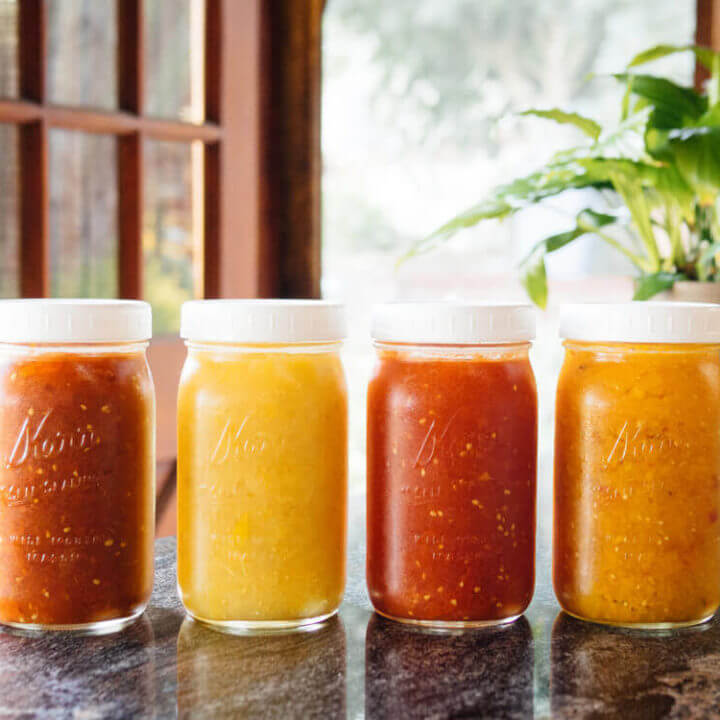
Fresh homemade tomato sauce without the need for blanching, peeling, seeding, straining or other traditional (and time-consuming) methods of processing.
Ingredients
- 15 pounds tomatoes, stems removed
- 8 tablespoons bottled lemon juice (optional, if canning)
Instructions
Refrigeration Method
- Working in batches, quarter or coarsely chop the tomatoes and add them to the bowl of a food processor. Pulse a few times to your desired level of chunkiness.
- Transfer the tomato puree to a large stockpot, then repeat Step 1 until all tomatoes are processed.
- Place the stockpot over medium-high heat and bring the puree to a boil. Reduce the heat and simmer uncovered, stirring occasionally, for 30 to 90 minutes until the tomato sauce is thickened to your liking.
- When the sauce is finished, let cool to room temperature, then transfer to jars and refrigerate for up to 1 week.
Alternatively, you can transfer the cooled sauce to freeze-proof containers or zip-top bags and freeze for up to 3 months.
(Tip: When storing the sauce in bags, portion them into 2-cup or 4-cup servings for ease of cooking, squeeze out the excess air and then flatten the bags before stacking and freezing.)
You can also freeze the tomato sauce in mason jars if you follow these tips.
Canning Method
- Prepare a boiling water bath and 4 to 6 quart-sized canning jars.
- Follow the directions above through Step 3. Remove the stockpot from heat.
- Transfer the hot tomato sauce to warmed jars, leaving about 1 inch of headspace.
- Stir in 2 tablespoons of bottled lemon juice per jar.
- Wipe the rims with a towel, then seal with lids and bands.
- Process the jars in a boiling water bath for 40 minutes, adjusting time for altitude as needed.
Notes
Properly canned tomato sauce will be shelf stable for at least 1 year.
Nutrition Information:
Yield:
8Serving Size:
1/2 cupAmount Per Serving: Calories: 156Total Fat: 2gSaturated Fat: 0gTrans Fat: 0gUnsaturated Fat: 1gCholesterol: 0mgSodium: 46mgCarbohydrates: 34gFiber: 10gSugar: 23gProtein: 8g
Nutrition information isn’t always accurate.
This post updated from an article that originally appeared on July 27, 2017.
More tomato recipes to try:
- How to Make Sun-Dried Tomatoes (Fast!) In the Oven
- Summer Means Salsa (Spicy Fermented Salsa, That Is)
- 4 Ways to Pickled Green Tomatoes
- Roasted Green Tomato Salsa Verde
- Bacon, Chicken, and Green Tomato Soup
- Can You Eat Tomato Leaves? The Answer Will Surprise You
View the Web Story on easy homemade tomato sauce.


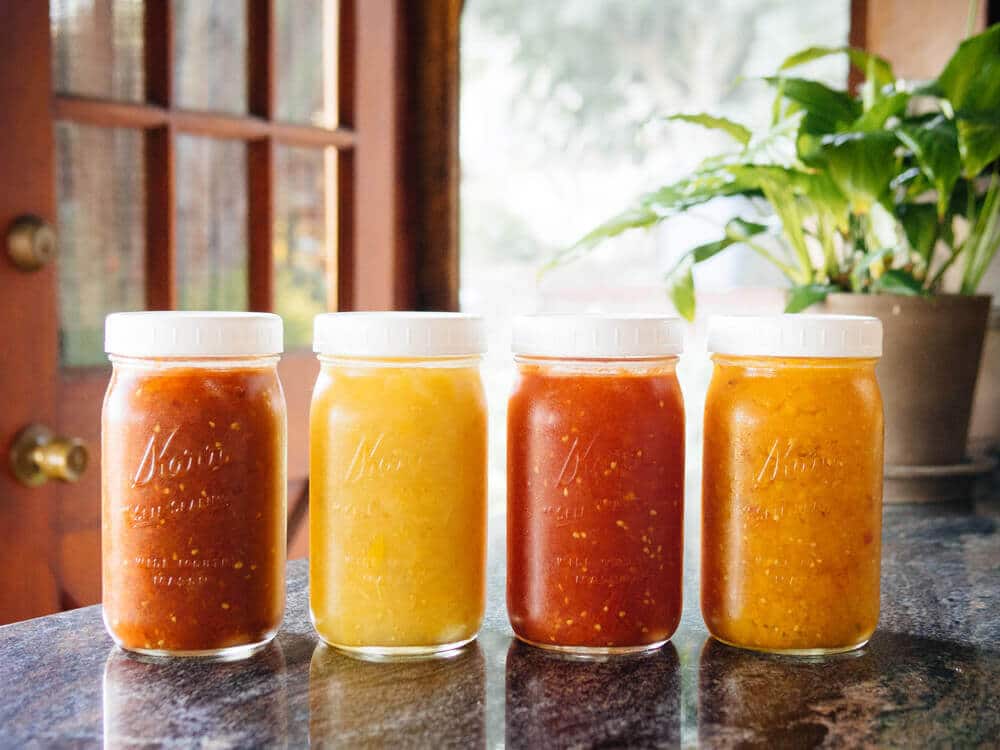
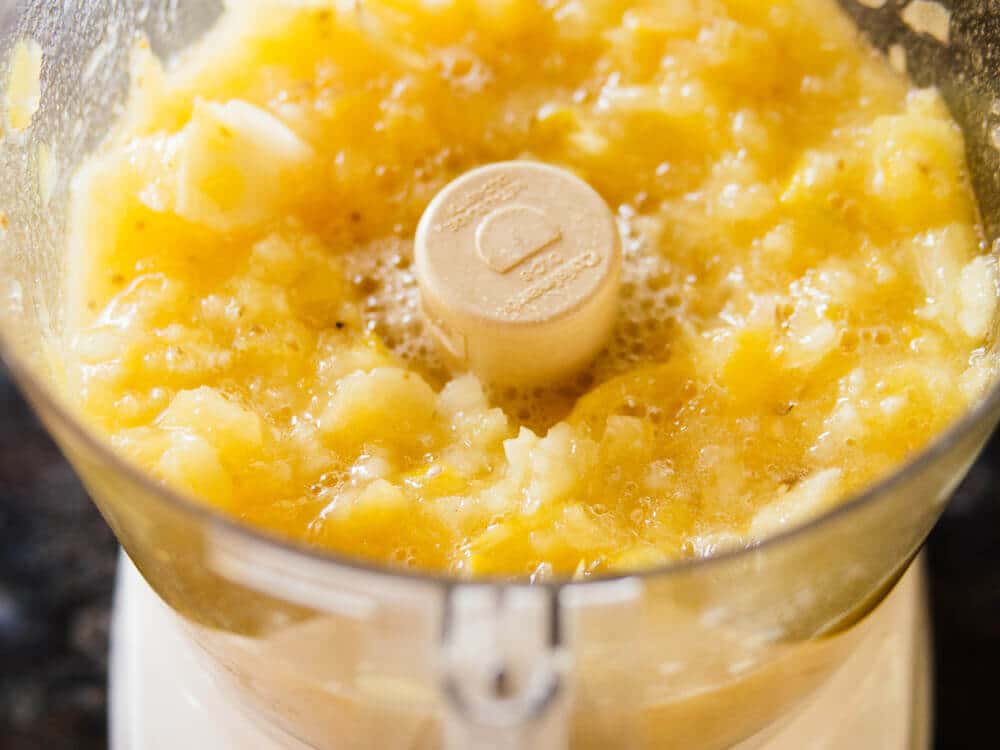
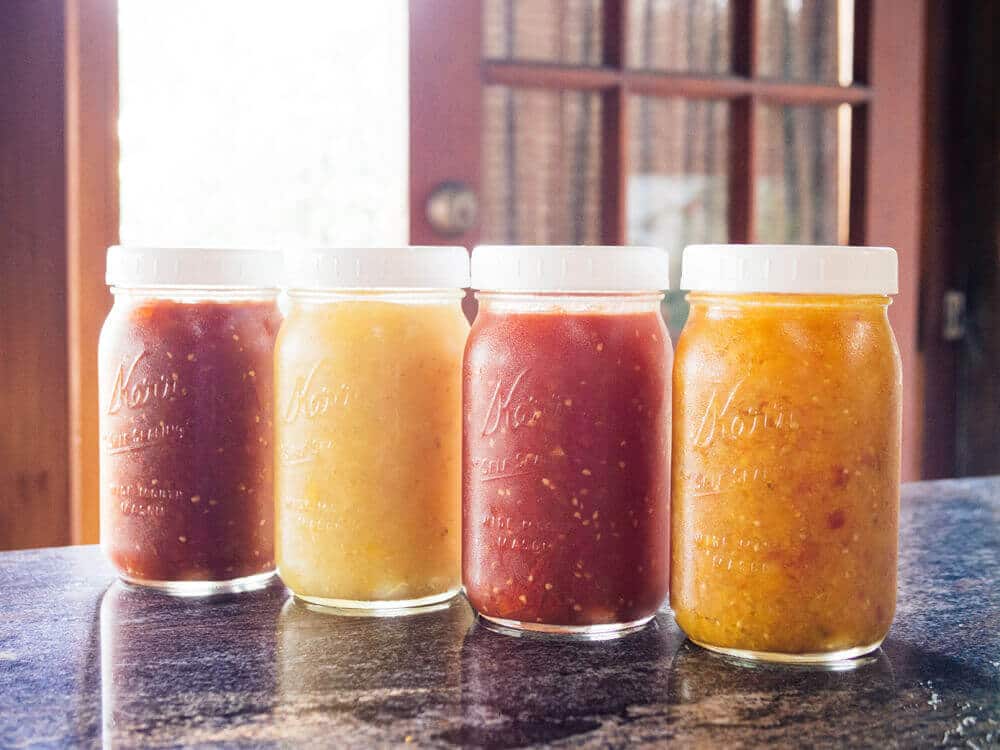













The calorie count is WAY off! The highest I could find for one full cup was 90 calories, and that was still much higher than average. This is actually an important part of recipes for some people.
Tomato skins, no matter how much you clean them, are known to stubbornly harbor botulism spores, which re NOT killed by boiling water bath canning. This is why most recipes call for peeling the fruit. The acidity of the product helps to prevent the spores from growing, so do not neglect to acidify as directed if you are canning! Freezing or pressure canning would be my preferred method of storing a skin-on tomato product.
Dear Linda, I enjoyed reading your post. I just spent DAYS blanching, peeling then cooking and all the rest. Ugh. It was a lot for a 79 year old woman with rheumatoid arthritis!
Then I found and took your advice and dispensed with most of that, only taking out the stem core and cutting off the tiny dot on the bottom.
Here’s my tip for you. Instead of putting the tomatoes in a food processor, which can be so messy, and spillage always happens, why not use an immersion blender in the pan. Works like a charm! Thanks to you, I’m going to make another round of tomato sauce and I’m not even dreading it! Cheers!
Blessings to you and thanks for your tips!
Typo…I’m only 70. Lol
“This Easy Peasy Homemade Tomato Sauce is a lifesaver! I used to dread making tomato sauce because of the time and effort it took to peel and seed the tomatoes. But this recipe is a game-changer! It’s so simple to make, and the results are just as delicious as traditional tomato sauce. The sauce is thick, rich, and flavorful, and it’s perfect for using in pasta dishes, pizzas, and soups. I’m so glad I found this recipe!”
As I had an abundance of cherry tomatoes (orange paruche was the variety) I thought I would give this recipe a try for canning tomato sauce as I have always peeled and seeded my canned tomatoes. I probably wouldn’t do it again, not because it wasn’t easy, but the sauce turned out with a bitterish flavor. But what do you do with a ton of cherry tomatoes? Give them away to eat fresh when they are at their peak I think.
Tomatoes and beans contain lectins too. They’re sharp and if your arthritis acts up in summer while you endure in yummy fresh tomatoes, that’s why.
I found your blog and was thrilled to find a non wasteful recipe. I forgot to add the lemon juice, are my tomatoes ruined?
If you canned them, yes. Have to use lemon juice or 1/2 teaspoon of citric acid. If freezing they are fine.
No they aren’t ruined. I have forgotten lemon juice plenty of times. They always recommend it but it’s fine.
Sorry, but yes, they are unsafe, ESPECIALLY as water bathing does not kill botulism spores. The acidification step is crucial, as tomato varieties are not as acid as they were in our grandmothers’ days. Better to keep your loved ones safe. For gold standard information on safe scanning techniques, I recommend the website of the National Center for Home Food Preservation at the University of Georgia (nchfp.uga.edu), The Ball series of books on food preservation, and healthycanning.com. They do the scientific testing and make recommendations based upon proof.
Thanks for this info and recipe Linda! I have a few plants of small bell shaped yellow tomatoes. With my large tomatoes I make sauce and freeze for the winter months. Today I picked 4 quarts of the bell yellow tomatoes and wondered what to do with them and thought how would I ever de-skin them! Boom, no need.
can i add all my ingredients to the sauce while its cooking?
Very nice of you to post this. We started with making just tomatoes but began adding onion, peppers, garlic, oregano and some other spices. We were wondering what to do with all of our tomatoes, now we want more tomatoes. We decided to keep one jar out of the water bath and that will be for tomorrows dinner. It was awesome. It was easy. It was very appreciated.
I canned tomatoes without the lemon juice. Will they be ok or should I discard them?
Ball Blue Book does not call for the lemon juice.
Blue book does say to add lemon juice. In my blue book it is very bottom of page 24 step 9.
The Ball books DO call for acidification. You should be sure to get the most current edition, as updates are frequently made as we learn more about canning safety.
I’m going to try this with yellow tomatoes for the reduced histamine. I had to research and found this regarding nutrition retained from leaving skins on and seeds in from West VA University. https://researchrepository.wvu.edu/cgi/viewcontent.cgi?article=5115&context=etd
Diane thank you for this research article. This is the type of research that I would choose to do if I was in that field or graduate study! Very interesting! Thanks again!
It’s going to be my first time canning anything and I have been scouring the internet trying to find a recipe that says its safe to can tomatoes, tomato sauce, passata etc. without peeling them first.
When I looked up why you had to peel, it always mentioned something to do with bacteria and that peeling was necessary. Has this information changed or was it wrong to begin with ? I plan on using 1/4 teaspoon of citric acid per pint of tomato sauce but just want to confirm that leaving the skins on is okay and how long do I water bath the jars for ?
I toss tomatoes not peeled with onion, garlic and herbs in food processor. Put them in a pot adding little olive oil and spice. Cook some. Cool and put sauce in freezer bags and freeze. Very handy for many meals.
Oh and I add some tomato paste.
We puree it all with a stick blender and do it in 2 batches 1 very chunky and 1 smooth…then combine! Also, add grated carrot for sweetness while cooking. Just today we gathered all the red and orange Toms for this project!
Thank you for the recipe on no-peel, no-seed removal sauce. AND a big thanks for the mason-jars-in-freezer advice. I forgot to add lemon juice to my roasted and seasoned cherry tomato sauce, and instead, transferred to wide-mouth quart mason jars to freeze, per instructions!
I did this with cherry tomatoes and the first time, no issue with skins. The second time, even after an immersion blender, the skins feel like little sticks and are hard to chew. What else can I do? I have an old fashioned food mill, but will be time consuming with the size of the batch. Any other suggestions?
In the process of making this now. We have 2 cup jars – so I’m guessing it’s 1 tablespoon of lemon juice per jar? Thanks!
Taste it ….add less you can always add more. ‘ Do not ruin a good/great batch of red sauce!
I love that someone finally posted tomato sauce without all the work of blanching, cooling, peeling and de-seeding. I have been making this style of tomato sauce for over 20 years. I just clean, quarter and core the tomatoes, toss them into the Vitamix and whiz until no seeds or skins are seen. Then cook down with a bit of salt until desired thickness and proceed to can with a bit of citric acid in boiler-canner. So simple and no wasted food to throw out. So very tasty and sweet….and strictly just tomatoes!
Thank you for posting this.
THIS right here is exactly what I have been looking for! Just the thought of the lengthy canning process has simply been way too overwhelming to me!
I always grow way too many tomatoes so this easy method is a game-changer for me.
Must tomatoes be sliced/blanched for freezing or is it okay to freeze whole in a freezer container? Also, what do you suggest as the length of time it can be kept in the freezer?
You can freeze tomatoes whole! I wrote about that here: https://gardenbetty.com/preserving-tomatoes-by-freezing/
As long as your tomatoes are well sealed in a bag or container, they should be good in the freezer for 6 to 12 months, at least.
Hi there, love the idea of using skins and seeds (in the past, I have peeled the tomatoes but retained the seeds). One question: Is there any reason I can’t still use some garlic and olive oil in preparing an otherwise neutral sauce? Also: Any reason not to season with salt? Thanks in advance!
You can certainly use olive oil and garlic when preparing your sauce. I’d wait until the very end to add salt though, just to make sure you won’t concentrate it as the sauce cooks down.
Well, traditions, like Italian cooking, are based on many years of experience. They discovered that peel and seeds were not good for you, especially if not well cooked. Why would they go through all that?
Today we know that they contain lectins, proteins dangerous to your gut’s walls. I would not discount traditions so fast…
Giuseppe.
Whether or not lectins are truly harmful to your health is a complex issue, as they have to be consumed in high concentrations or in isolation, as they are in medical experiments. But tomato sauce is generally cooked anyway, so if you were sensitive to lectins, the simple act of cooking it for your pasta greatly reduces the lectin content.
Thank you for using the term “canning”. I had never heard the term “jarring” until one of the celebrity cooks use it on her show;
Hello, I finally washed and cut up mostly green tomatoes, some changing color, and a few red tomatoes. I have them cooling now. I did not remove the skins, and with limited freezer space, I may pick up a few canning jars tomorrow, and try canning the batch. Years past, I would just cook them to sauce, and make lasagna within a week of making the batch. This year, I’ll do something different. I thought about tart pear and apple with green tomatoes as a chutney….. honey, to sweeten, a dash of salt maybe, cardamom, and cinnamon for a holiday pork roast…. ? Thank you for your post. It is encouraging others do similar cooking with tomatoes grown at home. 🙂
Yes yes yes, Renee. It can be a long or short process depending on “water bath” or the pressure cooker. I’ve been canning for about 50 years. The results, though, are great. I’ve canned a lot of different foods.
Use the citric acid for caning tomatoes.. The lemon juice makes the tomatoes to tart and strange tasting!
I’ve never canned before but have alot of tomatoes ripe and readyfor harvesting and sadly not enough freezer space. It seems like every recipe I have looked at says you have to peel them before canning due to bacteria on the skin. If you have been canning fir 50 yrs and have always done it that way, then thats good enough for me.
How long do you reccomend processing pint size jars for using the water bath method ?
U should contactUSDA for safe canning methods.or if u have a local county extension or master food preservers.also recommended USDA info is on internet
Are you saying that you can water bath can this recipe with peelings? I thought peelings in this method would lead to botulism?
Yes, you can process these jars in a boiling water bath per the instructions in the recipe. Just make sure you add the bottled lemon juice (as directed), and wash your tomatoes normally before using.
U should contactUSDA for safe canning methods.or if u have a local county extension or master food preservers.also recommended USDA info is on internet you should always peel tomatoes when canning.bacteria lives in the stem end&can be on peelings.you need to prevent botulisim.
I have been doing this process for years and no one has gotten sick yet .
You’re my hero! Have made 22 quarts of sauce already, peeling each one of those little gems! Now I found YOU! Ball Book of Canning also doesnt say you have to peel them. What a good idea to make a basic sauce which I can “doctor” later!
I have pint jars instead of quart. How much lemon juice to add to pints?
Use 1 tablespoon bottled lemon juice per pint.
I’ve been chopping up extra tomatoes at the end of each week and freezing them. Could I defrost and use them for canning? Is that safe? Thanks!
Yes, frozen fruits and vegetables are suitable for canning.
Thank you!
I do the same! No need to fuss with seeding and peeling, I throw in a mix of tomatoes and simmer with a quartered onion, salt and butter (Marcella Hazan’s recipe). Nothing from the grocery store can compare.